高中英语牛津译林版 模块8 Unit3 The world of colour and light Task 课件(共21张)
文档属性
| 名称 | 高中英语牛津译林版 模块8 Unit3 The world of colour and light Task 课件(共21张) | 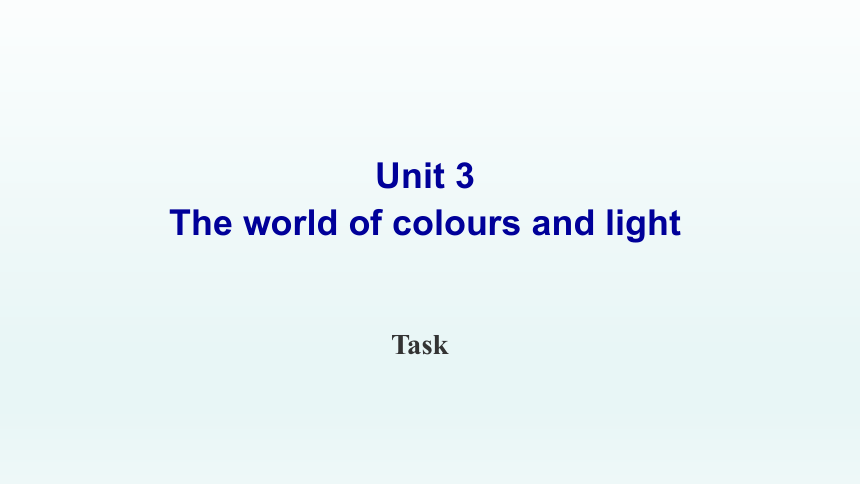 | |
| 格式 | zip | ||
| 文件大小 | 264.2KB | ||
| 资源类型 | 教案 | ||
| 版本资源 | 牛津译林版 | ||
| 科目 | 英语 | ||
| 更新时间 | 2019-04-27 22:16:21 | ||
图片预览

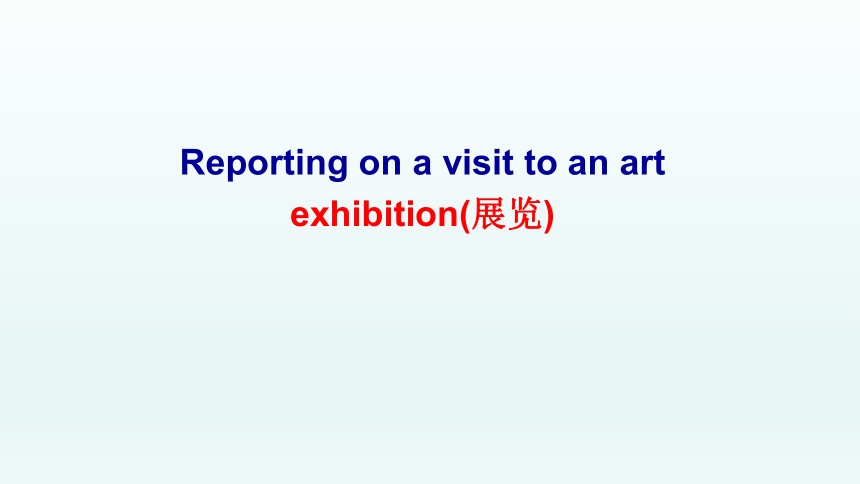
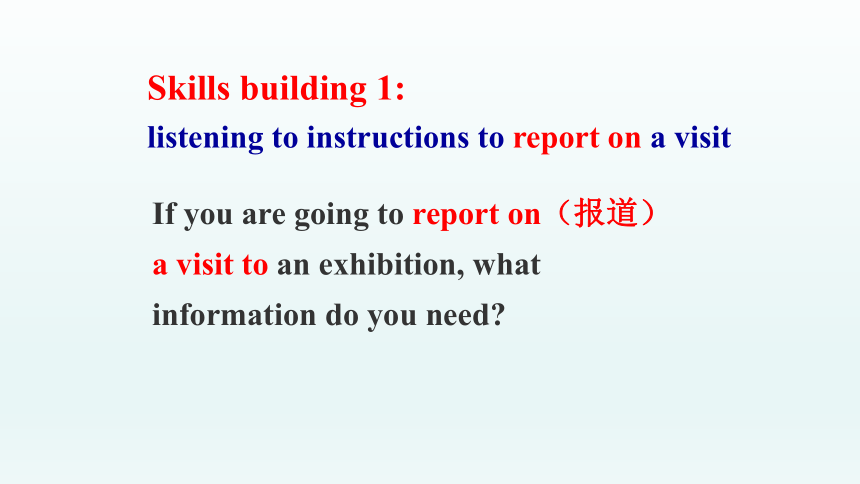
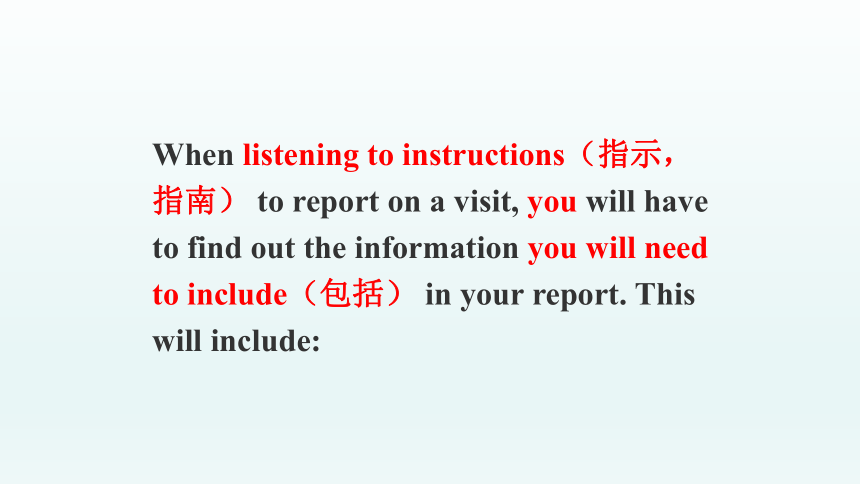
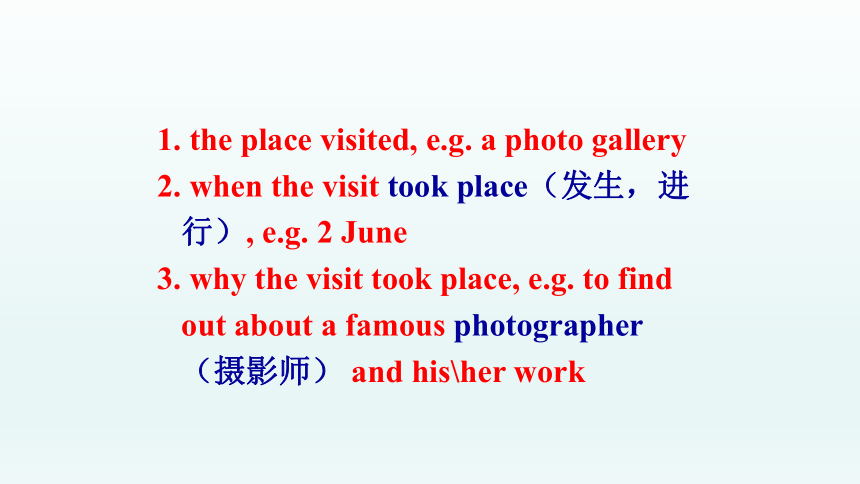
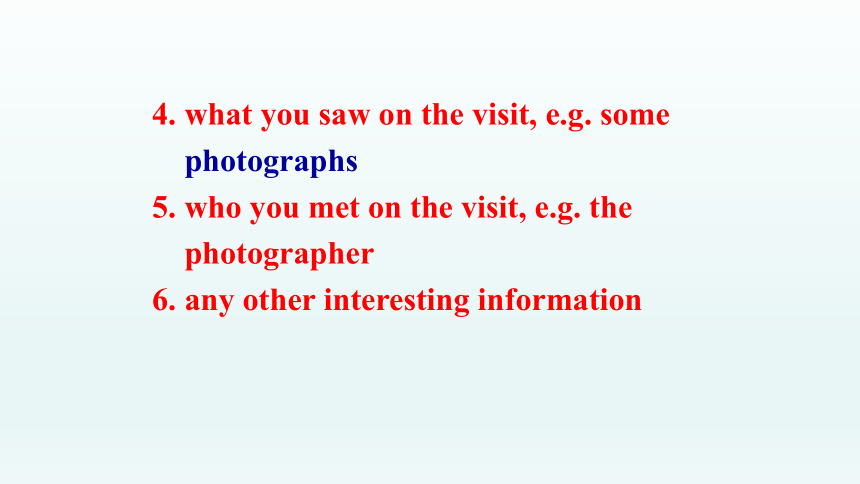
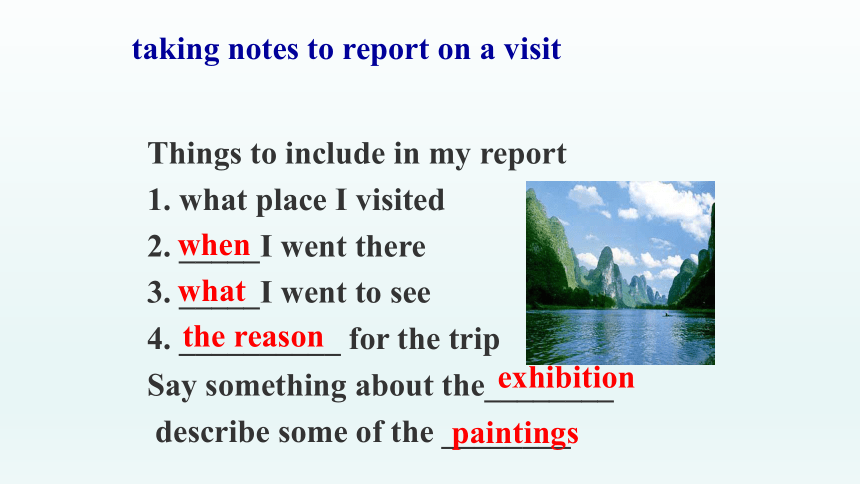
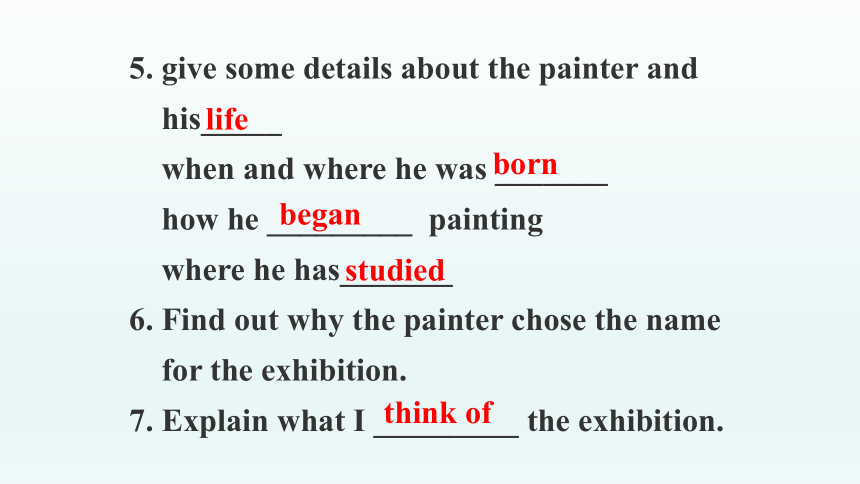
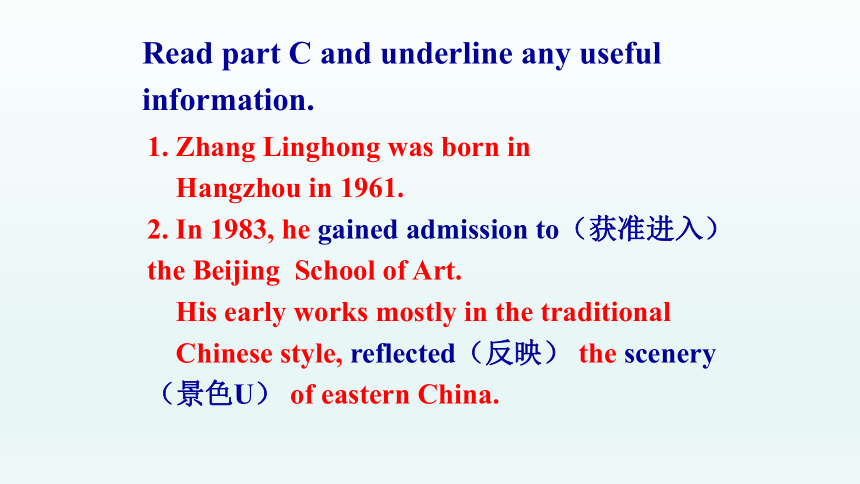
文档简介
课件21张PPT。Unit 3
The world of colours and lightTask Reporting on a visit to an art exhibition(展览)Skills building 1:
listening to instructions to report on a visitIf you are going to report on(报道) a visit to an exhibition, what information do you need?When listening to instructions(指示,指南) to report on a visit, you will have to find out the information you will need to include(包括) in your report. This will include:
the place visited, e.g. a photo gallery
when the visit took place(发生,进行), e.g. 2 June
why the visit took place, e.g. to find out about a famous photographer(摄影师) and hisher work4. what you saw on the visit, e.g. some
photographs
5. who you met on the visit, e.g. the
photographer
6. any other interesting informationtaking notes to report on a visit
Things to include in my report
1. what place I visited
2. _____I went there
3. _____I went to see
4. __________ for the trip
Say something about the________
describe some of the ________ whenwhatexhibitionpaintingsthe reason5. give some details about the painter and
his_____
when and where he was _______
how he _________ painting
where he has_______
6. Find out why the painter chose the name
for the exhibition.
7. Explain what I _________ the exhibition.lifebornbeganstudied think ofRead part C and underline any useful information.1. Zhang Linghong was born in
Hangzhou in 1961.
2. In 1983, he gained admission to(获准进入) the Beijing School of Art.
His early works mostly in the traditional
Chinese style, reflected(反映) the scenery(景色U) of eastern China.3. He then set up a studio(工作室) in Hangzhou.
4. In the 1990s, he won a scholarship to
study in the USA.
5. Glance of Guilin is a collection of(集为一体的) 12 paintings created between 2003 and
2004.6. The first painting in the Glance of
Guilin collection is called Guilin
Heights(高度), and measures(量起来) over three meters tall.Skills building 2:
asking technical questionsSometimes we need to ask technical questions about why and how something is done in a particular way. We can use these sorts of questions to find out technical information.Where did you get the idea from?
What did you do first?
What did you do next?
How did you get this effect?
How long did it take you to finish your work?
How did you decide what to call it?
What do you think of it?Skills building 3:
writing a report on a visitWhen we are writing a report, one of the most difficult things is to organize the information in an order that will make sense(讲得通)to (对) the reader. When we are writing about a visit, we can use the following structure to help us:heading(标题) -what the report is about
introduction-place of visit/date of visit/what was seen/people met
description of(对…的描述) what was seen
description of people met(后定)
conclusion-what you thought of the visit Because you are writing about something that has happened, you should use the past tense(过去时).writing a reportYou want to write a report on your visit to the art gallery. Get into groups and discuss the exhibition with each other. Then, write your own report. Use the information before to help you.Possible example:Report on(关于) the visit to ____________
Introduction
__________________________
____________________
___________________________________________________Glance of GuilinPlace of visit: City Art GalleyDate of visit: 29th MayWhat was seen: an exhibition by Zhang LinghongThe exhibition
1 The collection
______________________________
_______________________________
______________________________
_______________________________
______________________12 paintings, printed between 2003 and 2004; effect was made with a knife and a fork; a year to take the photographs and two more years to finish all the paintings.2 Guilin Heights:
_______________________________
_______________________________
_______________________________
________________________
over 3m tall, focusing on several steep hills, painted in a unique way; named because it shows the hills around Guilin and because of its sizeThe artist:
___________________________________________________________________________________________________
______________________________
_______________________________
Conclusion
_____________________________________________Born in Hangzhou in 1961, gained admission to Beijing School of Art in 1983, set up a studio in Hangzhou after graduation, studied in the USA in the 1990s, held an exhibition of his workFantastic and impressive, cannot be missedThank you
The world of colours and lightTask Reporting on a visit to an art exhibition(展览)Skills building 1:
listening to instructions to report on a visitIf you are going to report on(报道) a visit to an exhibition, what information do you need?When listening to instructions(指示,指南) to report on a visit, you will have to find out the information you will need to include(包括) in your report. This will include:
the place visited, e.g. a photo gallery
when the visit took place(发生,进行), e.g. 2 June
why the visit took place, e.g. to find out about a famous photographer(摄影师) and hisher work4. what you saw on the visit, e.g. some
photographs
5. who you met on the visit, e.g. the
photographer
6. any other interesting informationtaking notes to report on a visit
Things to include in my report
1. what place I visited
2. _____I went there
3. _____I went to see
4. __________ for the trip
Say something about the________
describe some of the ________ whenwhatexhibitionpaintingsthe reason5. give some details about the painter and
his_____
when and where he was _______
how he _________ painting
where he has_______
6. Find out why the painter chose the name
for the exhibition.
7. Explain what I _________ the exhibition.lifebornbeganstudied think ofRead part C and underline any useful information.1. Zhang Linghong was born in
Hangzhou in 1961.
2. In 1983, he gained admission to(获准进入) the Beijing School of Art.
His early works mostly in the traditional
Chinese style, reflected(反映) the scenery(景色U) of eastern China.3. He then set up a studio(工作室) in Hangzhou.
4. In the 1990s, he won a scholarship to
study in the USA.
5. Glance of Guilin is a collection of(集为一体的) 12 paintings created between 2003 and
2004.6. The first painting in the Glance of
Guilin collection is called Guilin
Heights(高度), and measures(量起来) over three meters tall.Skills building 2:
asking technical questionsSometimes we need to ask technical questions about why and how something is done in a particular way. We can use these sorts of questions to find out technical information.Where did you get the idea from?
What did you do first?
What did you do next?
How did you get this effect?
How long did it take you to finish your work?
How did you decide what to call it?
What do you think of it?Skills building 3:
writing a report on a visitWhen we are writing a report, one of the most difficult things is to organize the information in an order that will make sense(讲得通)to (对) the reader. When we are writing about a visit, we can use the following structure to help us:heading(标题) -what the report is about
introduction-place of visit/date of visit/what was seen/people met
description of(对…的描述) what was seen
description of people met(后定)
conclusion-what you thought of the visit Because you are writing about something that has happened, you should use the past tense(过去时).writing a reportYou want to write a report on your visit to the art gallery. Get into groups and discuss the exhibition with each other. Then, write your own report. Use the information before to help you.Possible example:Report on(关于) the visit to ____________
Introduction
__________________________
____________________
___________________________________________________Glance of GuilinPlace of visit: City Art GalleyDate of visit: 29th MayWhat was seen: an exhibition by Zhang LinghongThe exhibition
1 The collection
______________________________
_______________________________
______________________________
_______________________________
______________________12 paintings, printed between 2003 and 2004; effect was made with a knife and a fork; a year to take the photographs and two more years to finish all the paintings.2 Guilin Heights:
_______________________________
_______________________________
_______________________________
________________________
over 3m tall, focusing on several steep hills, painted in a unique way; named because it shows the hills around Guilin and because of its sizeThe artist:
___________________________________________________________________________________________________
______________________________
_______________________________
Conclusion
_____________________________________________Born in Hangzhou in 1961, gained admission to Beijing School of Art in 1983, set up a studio in Hangzhou after graduation, studied in the USA in the 1990s, held an exhibition of his workFantastic and impressive, cannot be missedThank you
